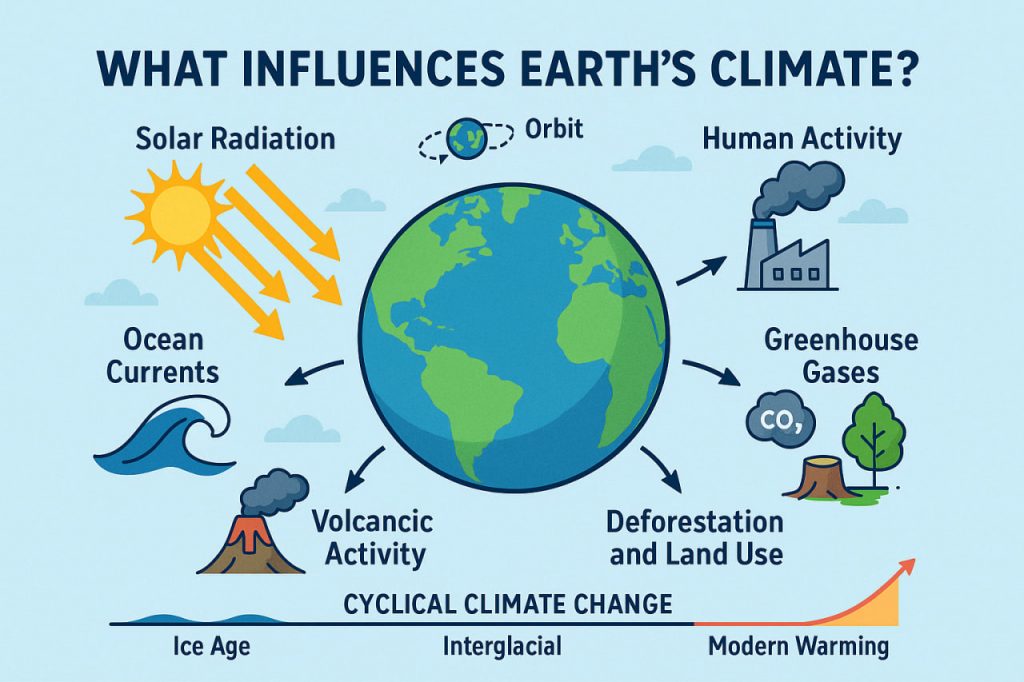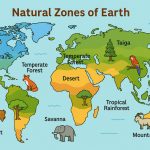Climate is the long-term pattern of temperature, humidity, wind, and precipitation in a given region. Unlike weather, which changes daily, climate shifts slowly over decades, centuries, or even millions of years. But what actually shapes Earth’s climate? The answer lies in a mix of natural and human-made factors—including a powerful one often overlooked: cyclical climate change that has affected the planet for millennia.
Key Factors That Influence Climate
1. Solar Radiation
The Sun is the primary energy source for Earth. Changes in the amount of solar radiation, such as solar cycles (about every 11 years), can cause small but noticeable shifts in climate over time.
2. Earth’s Orbit and Tilt (Milankovitch Cycles and more)
Over tens of thousands of years, Earth’s orbit changes shape (eccentricity), its axis tilts (obliquity), and it wobbles (precession). These cyclical patterns significantly impact how sunlight is distributed across the planet, leading to ice ages and interglacial periods.
3. Ocean Currents
Oceans store and move vast amounts of heat. Currents like the Gulf Stream distribute warm water around the globe. Disruptions in these currents can cause regional and global climate changes.
4. Greenhouse Gases
Gases like carbon dioxide (CO₂), methane (CH₄), and water vapor trap heat in the atmosphere. While naturally present, human activities—like burning fossil fuels and deforestation—have sharply increased their levels, amplifying the greenhouse effect.
5. Volcanic Activity
Large volcanic eruptions can cool the planet temporarily by releasing aerosols and ash into the atmosphere, which block sunlight. Over time, volcanoes also release CO₂, contributing to long-term warming.
6. Deforestation and Land Use
Removing forests reduces the Earth’s ability to absorb CO₂. Changing landscapes also alters local climates by changing how sunlight is absorbed or reflected.
7. Human Activity
Since the Industrial Revolution, humans have become a major force in climate change. Factories, cars, agriculture, and urbanization all contribute to rising greenhouse gas levels and altered natural systems.
The Role of Cyclical Climate Change
Earth’s climate has never been static. Long before humans appeared, the planet experienced dramatic temperature swings, glacial advances, and warm periods. These cycles are natural and have been driven by factors such as:
- Milankovitch cycles
- Plate tectonics shifting continents
- Natural carbon feedback loops
Understanding these natural cycles is critical because they help scientists distinguish between natural climate variability and human-driven changes. For example, we know that Earth is currently in a warming phase that goes far beyond normal natural fluctuations, largely due to human influence.
Why It Matters
Understanding what influences climate helps us:
- Predict future climate trends
- Prepare for changes like droughts, floods, or sea level rise
- Make informed policy decisions
- Adapt agriculture and infrastructure to new conditions
- Separate myths from science in climate debates
Conclusion
Earth’s climate is influenced by a complex mix of natural cycles and human activity. While natural forces like solar variation and orbital shifts have shaped climate for millions of years, the rapid warming we see today is primarily caused by human actions. Recognizing the role of cyclical climate change does not contradict human impact—it adds valuable perspective. A full understanding of both allows us to act responsibly and plan for a more stable future.
Glossary
- Climate: Long-term patterns of weather conditions
- Milankovitch Cycles: Long-term changes in Earth’s orbit and tilt
- Greenhouse Effect: Trapping of heat by gases in the atmosphere
- Aerosols: Tiny particles in the atmosphere that reflect sunlight
- Interglacial Period: A warm phase between ice ages


